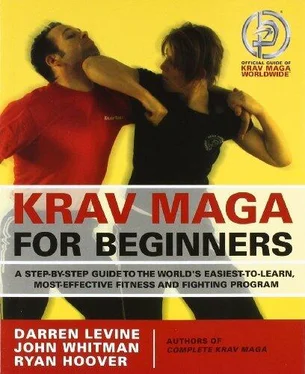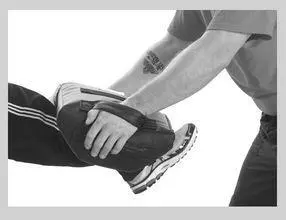
Front Kick (Vertical Target)
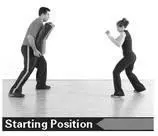
Starting Position:Left-leg-forward fighting stance.
1Bring your right leg forward and your knee up.
2Punch the foot, leg, and hip straight out (i.e., not upward, as in the front kick to the groin). As you kick, curl your toes upward to the top of your shoe, exposing and tightening the ball of your foot. Strike with the ball of your foot.
Recoil. You should be able to make a strong kick and then plant your kicking foot to any point, as needed, either in front or recovering back to a fighting stance.
Training Tips:Although this kick does rise from the ground (since your feet start on the ground), the general motion is horizontal so that you can strike a vertical target such as the opponent’s stomach.
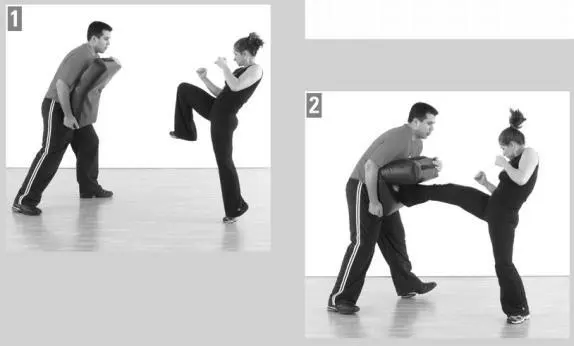
A round kick is, essentially, a front kick that “rolls over” at the last minute. Like the regular front kick, the round kick uses your instep or shin as the striking surface. In a more advanced version, you make contact with the ball of your foot. Round kick can be made to the side of an opponent’s knee joint, thigh, ribs, or even head, although we do not emphasize high kicks in Krav Maga.
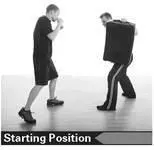
Starting Position:Left-leg-forward fighting stance.
1Raise your right knee almost exactly as you would for a front kick. However, as the kick rises, roll your hips inward so that the kick changes to a horizontal motion. It will help to pivot on the ball of your base foot so that the heel of your base foot turns forward.
2-3As your hips pivot, “chop” your leg onto the target and continue rolling your hip. Be sure to penetrate. Your knee should retain some bend even on contact to protect against hyperextension.
Recoil. You should be able to land forward with control, or bring your foot back into a fighting stance.
Training Tips:When you send this kick, be sure you are in a good position to swing your leg through the target, rather than just touching the outer surface of the target. For instance, if you’re kicking with your right leg, your body should be centered on the target so that you break through it. If you’re too far to the right, your kick will have lost its power by the time it arrives on target. If you start a little more to the left, your kick will penetrate more deeply and do more damage.

Think of a back kick as a stomp. You make contact with the bottom of your heel. Practice back kick first while in place, then practice it with a small step.
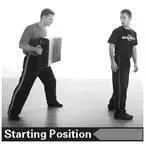
Starting Position:Passive stance. The target is behind you. First, recognize the threat with a brief, natural glance over your shoulder.
1-2Chamber your right knee in front of you, then send your right foot backward, toes down (not pointed), toward the target. Make contact with your heel going into the target. At the same time, bend your body forward and shift your hips (especially the kicking side) backward into the kick. As you kick, look around your arm, not over your shoulder. If you continue looking over your shoulder, you’ll be unable to bend and shift your weight into the kick.
Recoil. As a beginner, you may end up with your back to the target. Once you’ve mastered the kick, recoil while pivoting on your left (base) foot so that you’re facing the target.
Training Tips:One of the simplest ways to introduce the mechanics of a back kick is to imagine stomping an aluminum can. Raise your knee up in front of your body and stomp down on the imaginary can, using your heel. You will naturally put some weight behind the stomp by driving your hip down into the motion. Now, keep that motion in mind and make the same stomp… only this time backwards.
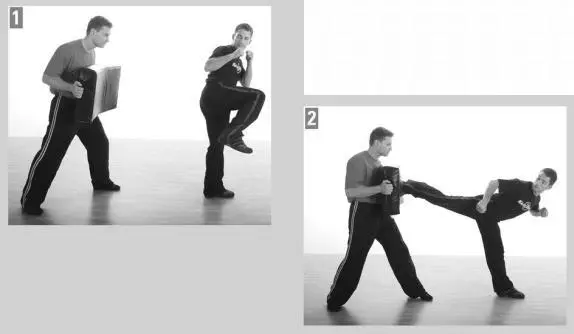
Unlike Front Kick to a Vertical Target (page 93), which is designed to penetrate and cause damage, the main purpose of a defensive front kick is to either stop an advancing opponent or to push a close opponent to a greater distance. For this reason, we kick with the whole foot. More surface area means the kick will push more than penetrate.

Starting Position:Left-leg-forward fighting stance.
1Bring your right knee up high, with your toes flexed back (not pointed). Send your foot forward, stomping with the entire foot. On contact, your knee should still be slightly bent to protect against hyperextension. Be sure to drive your right hip into the kick, and also engage your base leg for more power.
Recoil (either forward or back) quickly.
Training Tips:Although Krav Maga tries to reduce the importance of timing in its techniques, there is some timing involved here. If you kick too early, you may hyperextend your knee. If you kick too late against an approaching opponent, you may jam your kick and get knocked backward. Always practice the kick against a stationery target first, and then against a slowly advancing target, so that you learn to gauge your distance.
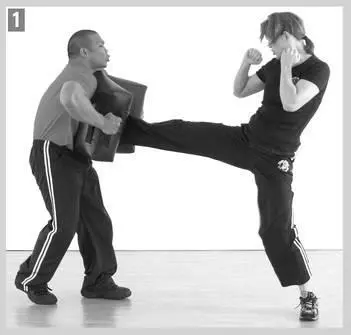
Knee strikes are to kicks as elbows are to straight punches. That is, they are essentially the same strike done at a shorter distance.

Starting Position:Left-leg-forward fighting stance in close proximity to your opponent.
1With your left hand, grab your opponent’s right arm somewhere around the elbow or upper arm. With your right hand, catch his shoulder and neck firmly by grabbing handfuls of skin. Push your right forearm against your opponent’s neck, keeping your elbow down. This prevents your opponent from dropping down and “shooting in” to grab your legs.
2Pull your opponent’s body forward and/or down while bringing your right knee up sharply, striking the groin, midsection, or face with the point just above your kneecap. Drive your hip forward and up to generate power.
Training Tips:One common mistake that beginners make is to throw their whole body at the opponent. This feels aggressive because they feel themselves burst toward the opponent. However, there is very little power in the knee itself. Instead, drive your knee and hip forward and into the attacker. This is much stronger, and also allows you to retain better balance and control your distance in the fight.
Читать дальше
